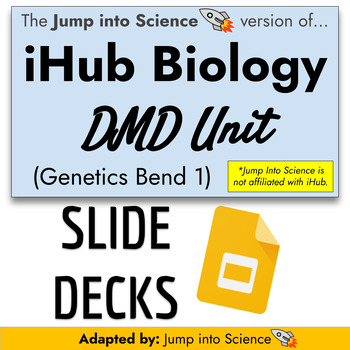iHub Biology NGSS Storyline DMD Bend - Slide Decks
- Google Drive™ folder

Also included in
- If you are looking for the best NGSS-aligned curriculum to use with your biology students, look no further than Inquiryhub. Developed by a team of researchers from University of Colorado Boulder and Northwestern University, this open-source curriculum follows a "storyline" approach in which all unitPrice $40.00Original Price $42.00Save $2.00
- If you are looking for the best NGSS-aligned curriculum to use with your biology students, look no further than Inquiry Hub (iHub). Developed by a team of researchers from University of Colorado Boulder and Northwestern University, this open-source curriculum follows a "storyline" approach in whichPrice $200.00Original Price $217.00Save $17.00
Description
If you are looking for the best NGSS-aligned curriculum to use with your biology students, look no further than Inquiry Hub. Developed by a team of researchers from University of Colorado Boulder and Northwestern University, this open-source curriculum follows a "storyline" approach in which all units begin with a puzzling phenomena. One of their units has been reviewed by Achieve and has been rated as an example of "High Quality NGSS Design" (which not many high school curriculums have been able to achieve). To learn more and access their full year Biology curriculum for FREE, click here.
| RESOURCE PREVIEW | | This is part of a full year bundle, CLICK HERE to view |
While their curriculum is free, I have made considerable changes to ALL of their materials. These changes were made to make the activities more interactive by adding visuals and additional lab activities, to provide more scaffolding (sentence starters, drag and drop activities, card sorts, etc.), to improve the pacing (the iHub units are notoriously too long!), and to provide timely moments of direct instruction and recall practice for past concepts. The Jump Into Science version of iHub is one that has been tried and tested on real students over the course of 5 years, and was created (and is still being improved) by a real working teacher.
What are these materials?
- Each material in this folder is an adapted version of the slides available for lessons 1-4 and 6-7 of the DMD storyline from iHub BUT heavy changes were made (6 lessons total)
- A pacing overview sheet --> The pacing estimate for this unit is about 30 school days (~6 weeks). More detailed information is provided upon purchase.
I have not purchased any of your other resources. Can I still use these?
Of course you can! However, these slides work BEST when paired with my other resources. Expect the lesson numbers, content, and pacing to differ from iHub’s. Click here to view ALL my resources for the DMD Bend. You can choose to purchase some of the resources, or all of them.
Why are your materials not exactly like the ones on the Inquiry Hub website?
I have taught these units for 5 years with 5 different cohorts of students. I have found most (if not all) of the weaknesses that exist in the curriculum. Many changes were made to improve the curriculum and therefore improve student success. If you have any questions about a change that was made and how to implement it in your classroom, feel free and email me at jennica@jumpintopd.com.
Where are the materials for iHub lessons 5, 8, and 9?
I skipped lesson 5 for pacing purposes- I might add it back in at some point. In years past I have given lesson 8 as an assessment. I don’t teach lesson 9 anymore for pacing reasons.
Where are the materials for lessons 10-15?
These are included in my separate resource for the CRISPR unit.
What order do you teach these units in?
The units can theoretically be taught in any order. However, these resources work best when taught in the following order:
iHub Ecosystems Unit:
- Serengeti Bend
- Trees Bend
iHub Evolution Unit:
- Addie Bend
iHub Genetics Unit:
- DMD Bend
- CRISPR Bend
*I do not teach Juncos because there is never enough time. I do not have resources for the Junco bend because of this.
Do you have other resources for the iHub Biology curriculum?
Yes! If you would like to purchase ALL of the above resources in one go, click here to view my iHUB FULL YEAR BUNDLE (note: the Juncos bend is NOT included). If you are interested in downloading a free preview of materials from every unit, click here. You can also click here and use the Custom categories links on the left hand side of the page to help you navigate my store.
Licensing Attribution
InquiryHub Biology is licensed under CC by 4.0
*Changes were made to all lesson materials.
I am not affiliated in any way with Inquiry Hub Biology or Next Generation Science Storylines.




